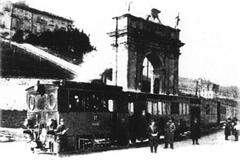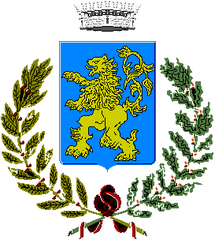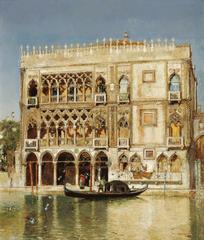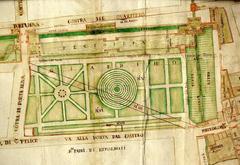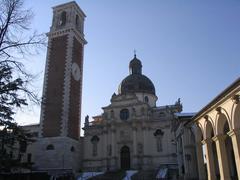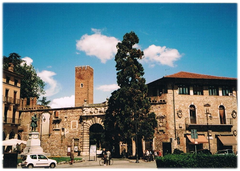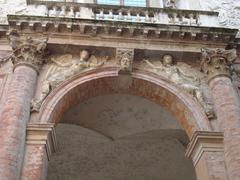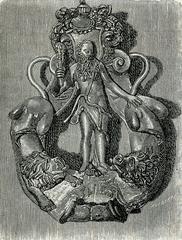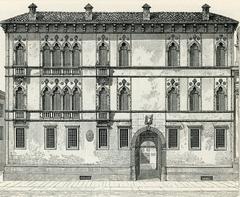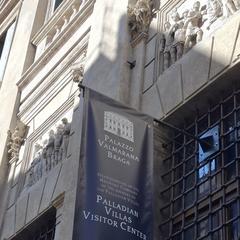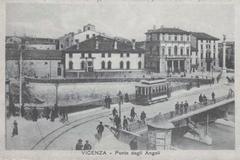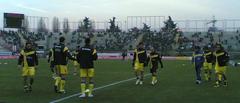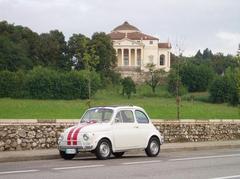
Palazzo Porto: Visiting Hours, Tickets, and Historical Sites in Vicenza
Date: 04/07/2025
Introduction
Palazzo Porto, located in the historic center of Vicenza, Italy, stands as a remarkable testament to Renaissance architecture and the innovative vision of Andrea Palladio. Commissioned in the mid-16th century by Iseppo da Porto, a member of one of Vicenza’s most prominent families, the palazzo reflects both the social aspirations and cultural vitality of the Venetian elite during a time of significant transformation. Although the building remains unfinished, its monumental façade, richly decorated interiors, and contributions from celebrated artists such as Paolo Veronese and Domenico Brusasorzi make it a focal point for architectural enthusiasts and cultural travelers alike.
Recognized as part of the UNESCO World Heritage Site “City of Vicenza and the Palladian Villas of the Veneto,” Palazzo Porto is celebrated not only for its architectural significance but also as a symbol of Vicenza’s Renaissance heritage. This guide provides essential details on the history, architectural features, practical visitor information—including visiting hours, ticketing, accessibility—and recommendations for exploring nearby historical sites, ensuring a rewarding experience for all visitors (Wikipedia; Vicenza Tourism Official Website; VicenzaVillePalladio).
Table of Contents
- Origins and Patronage
- Andrea Palladio’s Architectural Vision
- Construction and Artistic Highlights
- Historical Significance and UNESCO Recognition
- Visiting Palazzo Porto: Practical Information
- Visitor Tips and Cultural Etiquette
- Frequently Asked Questions (FAQ)
- Summary and Visitor Information
- References and Further Reading
Origins and Patronage
Palazzo Porto, situated on Contrà Porti, was commissioned by Iseppo (Giuseppe) da Porto around 1546. The Porto family, through strategic alliances—especially Iseppo’s marriage to Livia Thiene—sought to assert their influence and status among Vicenza’s patriciate. Their ambition for a grand residence was partly inspired by neighboring projects, such as the Thiene family’s palazzo, and was realized through a close collaboration with Andrea Palladio, then emerging as the leading architect of the Venetian Renaissance (Wikipedia: Palazzo Porto).
Andrea Palladio’s Architectural Vision
Andrea Palladio’s design for Palazzo Porto represented a turning point in his career. Influenced by his studies in Rome in 1541, Palladio harmonized classical Roman motifs with local Vicentine traditions. Notably, he elevated the ground floor—a practical adaptation to the Vicentine preference for inhabiting the lower levels—while incorporating a monumental façade and a sophisticated spatial arrangement that distinguished public from private zones.
The façade, with its use of Ionic half-columns, alternating triangular and segmental pediments, and sculptural elements, echoes ancient Roman precedents while remaining sensitive to the constraints of the urban site. Palladio’s published plans, notably in I Quattro Libri dell’Architettura (1570), present an even more elaborate vision than what was actually built, underscoring the iterative and ambitious nature of the design process (Wikipedia: Palazzo Porto).
Construction and Artistic Highlights
Construction began around 1546 but advanced slowly, with only part of the building habitable by 1549 and the façade completed in 1552. The project ultimately remained unfinished, with only the main block and a simplified foresteria realized. Despite this, the palazzo became a showcase for the talents of artists such as Paolo Veronese and Domenico Brusasorzi, whose frescoes adorned the principal rooms, and Bartolomeo Ridolfi, responsible for the stuccowork. Statues by Lorenzo Rubini, depicting Iseppo and his son Leonida as ancient Romans, crown the attic, underlining the family’s classical aspirations (VicenzaVillePalladio).
Over the centuries, Palazzo Porto underwent periodic renovations, but its Renaissance core and monumental façade remain largely intact, preserving the spirit of Palladio’s original vision (Wikipedia: Palazzo Porto).
Historical Significance and UNESCO Recognition
Palazzo Porto is a key work within Palladio’s oeuvre and an essential reference for understanding Vicenza’s urban transformation during the Renaissance. Its inclusion in the UNESCO World Heritage List in 1994, as part of the “City of Vicenza and the Palladian Villas of the Veneto,” attests to its enduring value and universal significance (UNESCO: City of Vicenza and the Palladian Villas of the Veneto).
Visiting Palazzo Porto: Practical Information
Visiting Hours
Palazzo Porto is not regularly open to the public as a museum. Access to the interior is typically limited to special events, guided tours, or arrangements with local cultural organizations. For the most current information on visiting hours and special openings, consult the Vicenza Tourism Official Website.
Tickets and Admission
Due to restricted public access, Palazzo Porto does not have a dedicated ticket office. When open for special events or guided tours, tickets are available through the Vicenza tourist office or local tour operators. Most visits focus on the exterior, which can be admired at any time from Contrà Porti.
For those interested in Palladian architecture, the nearby Palladio Museum in Palazzo Barbaran da Porto is open Tuesday to Sunday, 10:00–18:00, and provides an immersive experience with original drawings, models, and multimedia displays (Audiala).
Accessibility
The area surrounding Palazzo Porto is pedestrian-friendly and accessible, though Vicenza’s historic center includes some uneven cobblestone streets. Most civic museums nearby, including the Palladio Museum, offer wheelchair access and visitor facilities (Teatro Olimpico).
Location and Getting There
- Address: Contrà Porti, 36100 Vicenza, Italy
- By Train: Vicenza railway station is a 15-minute walk from the city center.
- By Car: Take the A4 motorway (Vicenza Ovest exit), follow signs to the city center. Public parking garages are available nearby (Evendo).
- By Bus: Local buses serve stops near the historic center.
Nearby Attractions
Palazzo Porto is ideally situated for exploring other UNESCO-listed sites including:
- Basilica Palladiana: Palladio’s iconic loggia and rooftop terrace.
- Teatro Olimpico: The first indoor theater in the world.
- Palazzo Chiericati: Home to Vicenza’s civic art museum.
- Corso Andrea Palladio: The city’s main boulevard lined with shops and Palladian palaces.
- Villa La Rotonda and Villa Valmarana ai Nani: Accessible via local excursions (My Earth is One).
Visitor Tips and Cultural Etiquette
- Dress Code: Modest attire is recommended, especially when entering churches or religious sites.
- Language: Italian is widely spoken, but English is common in tourist areas. Basic Italian phrases are appreciated.
- Local Customs: Many shops close for riposo (siesta) from 13:00 to 16:00. Enjoy the café culture for a local experience.
- Photography: Permitted outside; check policies during special events or tours.
- Safety: Vicenza is generally safe; use standard precautions and stay hydrated during summer months.
Frequently Asked Questions (FAQ)
Q: What are Palazzo Porto’s visiting hours?
A: Regular public access is not available; check with the Vicenza tourist office or official tourism portal for information on special events or guided tours.
Q: How can I buy tickets for Palazzo Porto?
A: Tickets are available through the tourist office or as part of guided tours when the palazzo is open.
Q: Is Palazzo Porto accessible for visitors with mobility challenges?
A: The exterior is accessible, though some nearby streets have cobblestones. Museums in the area provide full accessibility.
Q: Are guided tours available?
A: Many Vicenza walking tours include exterior visits to Palazzo Porto and other Palladian sites.
Q: What are the best nearby historical sites?
A: Basilica Palladiana, Teatro Olimpico, Palazzo Chiericati, and the Palladio Museum are all within walking distance.
Summary and Visitor Information
Palazzo Porto remains a cornerstone of Vicenza’s Renaissance heritage and a powerful symbol of Andrea Palladio’s architectural legacy. Though the interior is typically closed to the public, its monumental façade and historical resonance offer a compelling experience for visitors. For those passionate about Palladian architecture, a visit to the surrounding UNESCO-listed sites and museums—especially the Palladio Museum—is highly recommended.
Before your visit, check opening hours and special event listings on the Vicenza Tourism Official Website and consider guided tours for deeper insight. Enhance your exploration with the Audiala app, which offers curated audio guides and up-to-date visitor tips.
References and Further Reading
- Wikipedia: Palazzo Porto, Vicenza
- Wikipedia: Palazzo Porto (Italian)
- Vicenza Tourism Official Website
- VicenzaVillePalladio: Palazzo Iseppo da Porto
- Audiala: Centro Internazionale di Studi di Architettura Andrea Palladio di Vicenza
- Evendo: Palazzo Barbaran da Porto
- Teatro Olimpico - Visitor Information
- My Earth is One: Vicenza and the Palladian Villas
- Places of Juma: Vicenza Travel Guide

